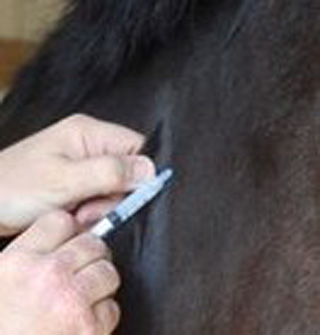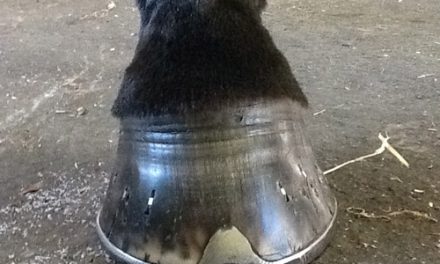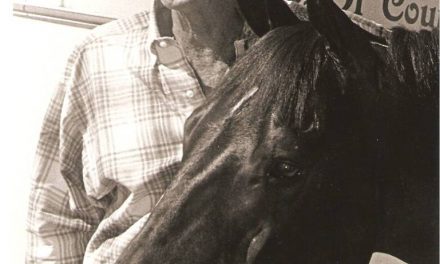The Way of Horses
“Do you give your own vaccinations?”
It’s a question I get asked frequently, and the answer is, “No”.
I could, but if I call my vet at 7 am on a Sunday morning with an emergency, she will be more receptive to coming out if she knows me and my horse.
In addition to that, I have someone in my corner in case of adverse reactions to the vaccinations.
Doctors and veterinarians use vaccines to induce immunity to specific diseases. Unfortunately vaccinations can occasionally cause unwanted reactions. These reactions can be as mild as a slight tenderness or swelling at the injection site, to the severe reaction of collapse or death.
Duane Chappell, D.V.M., Merck Animal Health, explains what may be the cause for a reaction to a vaccination:
* Antigen: these are modified or inactivated viruses, bacteria or parts of these organisms in the vaccine that trigger production of antibodies. The body may respond to the presence of the antigen by sending chemicals to fight the substance, resulting in inflammation. The inflammation causes the symptoms of swelling, redness, warmth and pain at the injection site. These unwanted reactions should subside in a day or two. Your veterinarian may recommend light exercise, icing the area, or administering a non-steroidal anti-inflammatory product.
* Adjuvant: these are substances that are added to the vaccine to enhance the immune system’s response to the antigen. Different vaccine manufacturers use different adjuvants, so trying a different supplier may help avoid reactions, if the adjuvant is the cause.
* Medium: the material used to grow the antigen may cause a reaction in sensitive individuals. For example, in humans who are allergic to eggs, an allergic response will be triggered if a vaccine component was grown in eggs.
* Physical: the technique used, and/or the location of the vaccination can trigger a reaction. Intramuscular (IM) vaccines need to be given deep into the muscle. The use of a one inch needle will not deposit the vaccine deep enough (in an average-sized horse), allowing the substance to seep between the skin and muscle. This will trigger an inflammatory response. The use of a 1.5 inch needle is considered best for administering IM vaccines to adult horses.
It is imperative that a new sterile needle and syringe is used for each vaccination. This is more important than cleaning the area. Studies have shown cleaning the area with alcohol has little effect. Should you want to clean the area, the steps are: shave the hair, scrub with an antiseptic soap, which must remain on the site for two minutes, and then rinse with alcohol.
The administration of the vaccine must not be near nerves, bones, ligaments or blood vessels. Horses with a history of getting a sore neck after a vaccination may receive vaccines in the buttocks. This will allow them to be able to lower their heads to eat and drink. The top of the rump is not recommended, as it will not allow drainage should an abscess develop. Beware of getting kicked if the buttocks are the chosen location. If you are considering giving your own vaccinations, have your veterinarian show you the proper location and technique.
* Movement: excessive movement of the horse while the needle is being inserted, and after it is place, can result in trauma to the area.
* Multiple Vaccinations: exposing the horse to several antigens, adjuvants, media and injection sites at the same time increases the odds of having a reaction. Using combination vaccines, or administering vaccines 10-14 days apart may be beneficial.
* Strangles Vaccine Contamination: when giving the intranasal live strangles vaccine, care must be taken that it does not contaminate the intramuscular injection sites. If the live strangles antigen gets taken into the muscle at the time of an IM injection, a severe local reaction will result. Contamination is possible if the horse snorts post-vaccination, allowing the live bacteria antigen to come in contact with the veterinarian’s hands or skin surface of the horse.
The intranasal live strangles vaccine should be administered on a different day than the intramuscular vaccines. a common protocol is to give the intranasal strangles vaccine AFTER all IM vaccines have been administered to every horse at the facility.
This helps eliminate the risk of the live strangles bacteria antigen from being “injected” intramuscularly via the IM needle.
* Active Disease: if a disease is already on the premises at the time of vaccinations.
Dr. Chappell goes on to say, “Adverse reactions to vaccinations are not always predictable, and just as in people, are an inherent and assumed risk associated with vaccinations. Prevention is always better for the horse because many diseases do not respond well to treatment and can be life threatening.”
Talk to your veterinarian, and review each horse’s vaccination requirements. Your veterinarian will assess the horse’s age, use, travel, housing, location and risk of exposure. It’s the perfect time for your veterinarian to get to know your horse.






